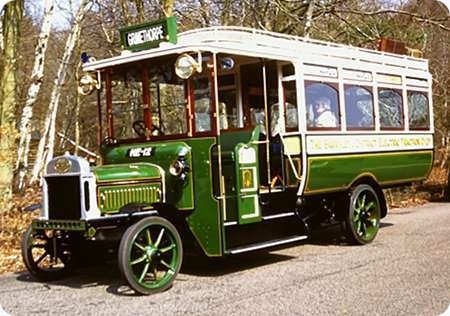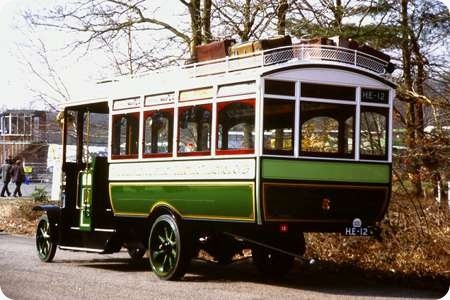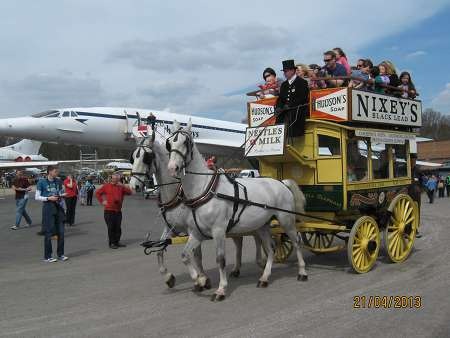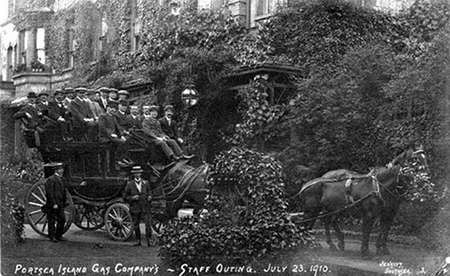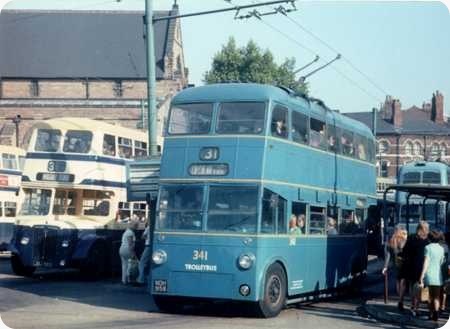Birmingham City – Leyland Titan PD2 – HOV 685 – 1685
Birmingham City Transport
1948
Leyland Titan PD2/1
Brush H30/24R
Here is a Leyland Titan PD2/1 with Brush H54R body, to Birmingham’s then standard design. She dates from 1948 and we see her in the Weymouth rally on 1 July 1979. She began her service at Yardley Wood depot and, Malcolm Keeley reports in his book in the Glory Days series, most of the batch so allocated from new remained there throughout their working lives. The others were at Perry Bar. The saga of the Brush bodies is not so happy, however. There had been some earlier disagreements between the builder and the operator, the former managing to convince itself that the product was entirely the opposite of what the operator wanted. This batch appears to have been the last of the Brush bodies for Birmingham.
Photograph and Copy contributed by Pete Davies
22/02/16 – 13:28
Interestingly, at the same time, Brush was building bodies for Manchester on Daimler chassis to Manchester’s post war standard design and there were a number of letters exchanged due to Brush’s "interpretations" which were not acceptable.
Phil Blinkhorn
22/02/16 – 16:14
Well, Phil, this makes me wonder if – by upsetting two of the country’s biggest operators – this saga is the reason Brush got out of building bus bodies not long afterwards.
Pete Davies
22/02/16 – 16:15
In 1949, coachbuilding at Brush employed around 1500 people and contributed £3 million towards the company’s £15 million productive total in that year. Then came the Korean War (1950-53), which brought a flood of armament related orders to Brush, who closed the coachbuilding activity in 1951 to concentrate resources on the more lucrative parts of the business.
Roger Cox
23/02/16 – 05:37
Yes, Roger, that diversion of resources for "War Work" would explain a lot!
Pete Davies
23/02/16 – 05:38
A most elegant vehicle indeed, unashamedly with very traditional appearance and further greatly enhanced by the very pleasing Birmingham livery.
Chris Youhill
23/02/16 – 10:48
And, of course, Chris Y, unblemished by adverts, a Brummie trademark, until the latter days. I confess to getting confused about the chrome/painted and aluminium rads on PD’s. I always thought the former to be PD1’s; the latter PD2’s. It doesn’t seem to work that way, unless the rad surrounds got changed about over the years!
Chris Hebbron
23/02/16 – 13:11
How right you are Chris H about the lack of disfiguring adverts – sadly of course we have to acknowledge that they are a valuable source of revenue but even accepting that some are totally "cheap" and abominable. Regarding PD1/PD2 radiator shells, just off the top of my head I’ve always thought that painted or chrome ones were frequently interchanged on PD1s – I just can’t think of any PD2 fitted with either of those.
Chris Youhill
23/02/16 – 16:46
Oh heck – I was so anxious to answer Chris H’s query that I overlooked the PD2 in the picture having a chrome shell. I wonder if batches of PD2s were therefore so equipped or has this one being "treated" during preservation – any informed answer would be appreciated please.
Chris Youhill
24/02/16 – 05:48
I think the chrome radiator shell was always an option but I can’t think of anybody except Manchester who took it. Even there they then went and painted them red!
David Beilby
24/02/16 – 05:49
All Manchester’s PD2s had chrome radiators but aluminium was the Leyland standard offering.
Phil Blinkhorn
24/02/16 – 05:52
I understand the choice of chrome pressed metal or cast aluminium radiator shells was down to the purchaser’s specification or at least it was for large scale orders. Most of Manchester’s PD2’s for example had the pressed metal shell which was chrome plated as delivered but always painted red at the first re-paint. This I understand was down to the frugal views of GM Albert Neil as the pressed metal version was cheaper.
Philip Halstead
24/02/16 – 05:53
Exeter took delivery of 17 PD2/1 in November and December 1947. They had consecutive registrations but the Leyland bodies of the first ten were in the 472 xxx series whilst the last 7 were in the 480 xxx series. I think the first lot had painted radiator shells and the later ones chrome. Certainly HFJ 144 (No. 17), which is preserved, has and has always had a chrome one. Some of these magnificent buses lasted 23 years in service with Exeter – and looked as smart at the end as when they were new!
David Chapman
24/02/16 – 08:16
Thanks for these informative replies folks, and I’m getting redder by the minute having just recalled that the two Kippax and District PD2s (GWX 823/4) had chrome shells – and I’ve even driven one of them when owned by Wallace Arnold !!
Chris Youhill
24/02/16 – 08:51
Regarding chrome painted radiators on Birmingham PD2’s, and 1685 in particular, more info here. www.wythall.org.uk/vehicles/vhov685.asp
Nigel Edwards
24/02/16 – 09:55
Philip H, Manchester’s PD2’s chrome radiators certainly were not all painted at first vehicle repaint. There was a massive variation across the fleet. There are plenty of photos showing older PD2s, from the early 1950s, in the all red scheme in the mid 1960s, with unpainted radiators and a good number of later vehicles in SELNEC colours still with the brightwork intact.
Radiators were painted if pitted but serviceable. The bulk of those painted was, I was once told, due to time pressure on the spray booth when repaints into the all red scheme were under way. Certainly many vehicles were repainted earlier than would have been the case had the scheme not been changed and one fewer masking job would have saved a little time. Another view was that those so painted were handled by a particular shift which never masked the radiator shell.
Almost all Parrs Wood’s and most of Queens Rd’s PD2s survived until SELNEC with the chrome untouched. Hyde Rd’s vehicles seemed to be mainly painted. A well known story is that a Burlingham bodied PD2 returned to Parrs Wood after being treated to the red scheme including a painted radiator. The batch were Parrs Wood’s pride and joy and the bus was sent back with tart instruction to remove the paint and never paint a Parrs Wood radiator again unless instructed. This certainly seemed to hold good throughout the 1960s.
Phil Blinkhorn
24/02/16 – 16:52
I particularly enjoy little tales like that one, Phil, it puts a human touch to it all, and makes our hobby that much more fascinating. It’s not just about the buses, it’s about the people who operated them and cared for them as well.
Thanks for sharing it.
Dave Careless
25/02/16 – 05:44
I found a photo on Facebook of Tynemouth and District no. 31, an all Leyland PD2/1, new to Tyneside Tramways and Tramroads Company, complete with chromed radiator shell. I’m unsure of the photo’s copyright so I’m reluctant to reproduce it here.
Richard Slater
25/02/16 – 16:25
PD1’s and PD2’s were all fitted with pressed steel radiator shells until around 1949. Due to material shortages just after the war only a few were able to be chrome plated at first, the majority being painted. Then Leyland introduced the cast aluminium shell which became standard, with the pressed steel version available as an option.
Halifax Corporation had nine PD2/1’s in 1947/48. All had chromed pressed steel shells apart from one which was painted orange. Throughout most of my childhood this was 101 (ACP 385) and it stood out from the others, but an official Leyland Motors photo shows a different one with the painted shell, and latterly in the mid-1960’s it had migrated on to a different bus again, so some swapping must have taken place at overhaul. Todmorden’s earlier PD2/1’s had painted steel shells, then came some chromed ones, then the later ones and the PD2/12’s had aluminium ones. Some later PD1’s – notably those supplied up to about 1952 to Central SMT – had the later aluminium version.
I actually preferred the painted radiator shells on many PD1’s and PD2’s. I often thought that the chromed version tended to look a bit too gaudy, especially on some of those in an otherwise sombre municipal livery, and they also emphasised the slightest dints and imperfections which they tended to pick up quite easily. What I hated was when some operators – notably Leigh Corporation – chose to paint the later aluminium radiator shells, which looked absolutely terrible. By contrast, the chromed AEC radiator always looked superb to my mind, and always looked dreadful if painted over – Leigh Corporation and Liverpool spring to mind as offenders.
I’ve wondered though, when Manchester CT painted their previously chromed shells, how did they get the paint to adhere and not just come off at the slightest scratch. Surely stripping the chrome plating would have been too much of a bother?
John Stringer
25/02/16 – 17:03
Some wonderfully interesting comments here, folks. Thank you!
Pete Davies
26/02/16 – 16:53
Thx, folks, especially John S, for helping to answer my question on "which PD rads when"! Another mystery solved!
Chris Hebbron
27/02/16 – 05:54
Richard, the photo of T&D 31 that you refer to is already on this site. Its in part two of my article about Northern General Transport Percy Main Depot. If memory serves, I bought my copy from a dealer at the Seaburn Historic Vehicle show.
Ronnie Hoye
28/02/16 – 06:05
Thanks Ronnie. I found it on another site, dedicated to matters Northumbrian. It was unattributed.
Richard Slater
02/03/16 – 06:24
Just catching up on the above after a few days out (due to computer death and replacement), and I can’t see that Phil’s statement about all Manchester PD2s having chromed radiator shells has been challenged. In fact the first 100 (3200-99) had cast aluminium shells, but since they were at Queens Road, I don’t suppose Phil saw much of them! See www.sct61.org.uk/
Peter Williamson
02/03/16 – 10:21
Peter,trying not to rely on memory I have been totally misled by a number of photos of both the Metro Cammell and Leyland bodied examples with shiny radiators when new.
As for not seeing much of them, the 53 provided some sightings and visits to the city centre others, and North Manchester wasn’t a foreign ground to me, the radiator shells just didn’t register!
Phil Blinkhorn
16/03/16 – 05:05
According to Eyre & Heaps Manchester specified the pressed radiator shell because it was cheaper to repair when the dozier brethren ran into the back of something. Personally I would have thought the tin shell would be less resistant to casual knocks than the heavy casting, but the decision was presumably based upon feedback from accident repair statistics. It’s worth noting that Salford specified shorter rads on their CVGs for similar reasons, while Birkenhead and Rochdale just bolted a big lump of angle iron across the grille to protect it!
David Jones
16/03/16 – 08:17
Perhaps, David, if the ‘dozier brethren’ had been required to pay for the repairs out of their wages, they might have been more alert to their surroundings . .
Pete Davies
Quick links to the - Comments Page - Contact Page - Home Page

